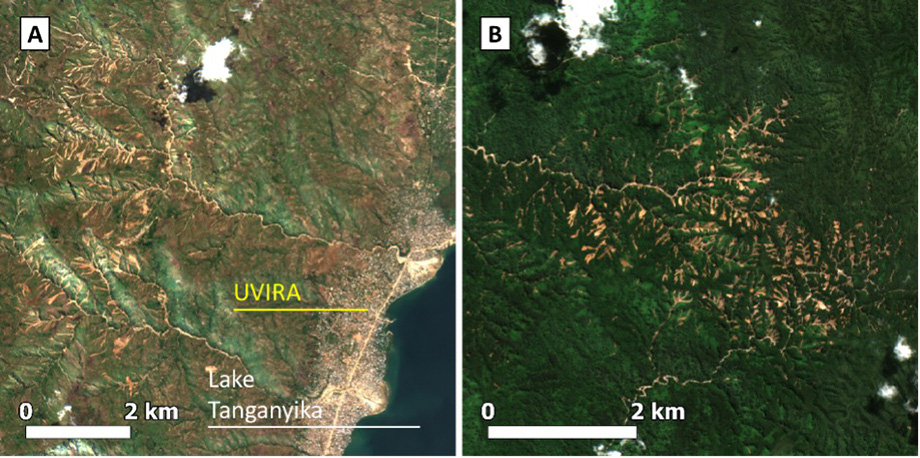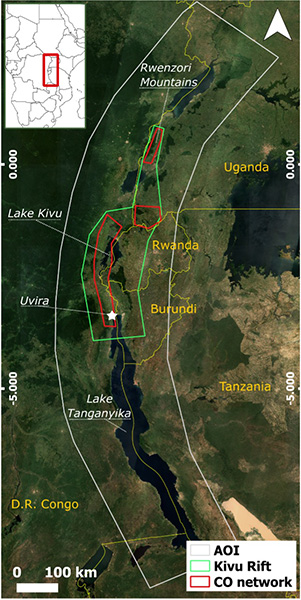GEOTROP
GEOmorphic hazards and compound events in a changing TROPical East Africa
The GEOTROP project (2022-2025) aims to assess the role of land transformation and climate change on the occurrence of geomorphic hazards (namely landslides and flash floods) in tropical East Africa. In the context of global change, it aims not only to address the problem of the current environmental situation, but also to anticipate the potential effects of human-induced climate and land use/land cover changes on the occurrence of future extreme events and their associated risks.
This 3-year project is funded by the Belgian Science Policy Office (BELSPO) under the BRAIN-be 2.0 programme (Contract N B2/223/P1/GEOTROP). The project is coordinated by the Royal Museum for Central Africa (RMCA), in collaboration with the Vrije Universiteit Brussels (VUB), the European Center for Geodynamics and Seismology (ECGS), the National Museum of Natural History (NMNH), the Ecole & observatoire des sciences de la Terre (EOST), the Centre national de la recherche scientifique (CNRS) and the Helmholtz Centre for Environmental Research (UFZ).

CONTEXT & OBJECTIVES
Landslides and flash floods are geomorphic hazards (GH) that often result from a combination of interacting processes across multiple spatial and temporal scales. GH events are linked to climate drivers (e.g., rainfall intensity) and land drivers (e.g., vegetation patterns). Land transformation such as deforestation has impacts on GH events and climate change will alter many drivers.
The tropics are environments where GH are under-researched. In mountainous regions, high population densities with high societal vulnerability are common, frequently on the rise. GH events disproportionately impact these regions. In the future, the frequency and/or impacts of GH events will be more severe; not only due to, for example, climate change and deforestation, but also due to population growth and increased exposure to disasters.
In many instances, landslides and flash floods occur very quickly. Landslides and flash floods frequently co-occur and interact, leading to events with more severe impacts. The combination of processes (climate drivers and/or hazards) leading to a significant impact is referred to as a ‘compound event’. Although many GH can be assumed to be caused by compound events, the understanding, analysis, quantification and prediction of such events is still in its infancy, especially at a regional level.
GEOTROP aims to assess the role of land transformation and climate change on the occurrence of GH compound events in tropical East Africa.
The specific objectives (SO) are:
- SO1: To develop an unprecedented spatio-temporal regional inventory of GH events;
- SO2: To understand the spatial distribution of the GH events in the landscape, and to assess the role of land transformation on their occurrence (location of GH events);
- SO3: To uncover the interplay of multiple land and climate drivers in triggering GH compound events (timing of GH events);
- SO4: To project the future evolution of GH compound events so that future hazard and risk hotspots can be identified.
In addition to these four SO, GEOTROP also aims to strengthen capacities of African institutions involved in disaster risk reduction (DRR).
STUDY AREA
The Area of Interest (AOI) of GEOTROP is the western branch of the East African rift; a mountainous region characterized by a large range of tropical climates and environmental conditions. Alongside a natural landscape diversity, this AOI is characterized by an alternation of contrasted pristine and highly human-transformed landscapes. The deep understanding of the AOI is a key for the achievement of the project, constituting the ideal location for our research with:
- A global hotspot of GH due to particularly favorable environmental conditions. Despite the recent research led by RMCA in the AOI, important research gaps remain regarding the understanding of climate and land drivers of GH at the regional level;
- A strong north – south climate gradient associated with the Inter-Tropical Convergence Zone (ITCZ) dynamics and influenced by climate oscillations such as the Indian Ocean Dipole (IOD) and ENSO which contribute to a frequent succession of extreme dry and wet periods;
- A hotspot of climate change with projected changes in both temperature and mean and extreme rainfall patterns;
- A tropical environment with uncontrolled urbanization and deforestation;
- Diverse landscapes where soil and climate are very favourable for agriculture expansion;
- A high population density (frequently > 300 inhab/km2) that is on the rise, high vulnerability, and a strong societal need of climate and hazard process understanding at the border between six countries;
- A unique long-term expertise in the region at the RMCA and its partners.

METHOD
In GEOTROP satellite remote sensing approaches will allow to obtain high accuracy constraints on the timing and location of GH events over this large region. Since cloud-covered conditions are pervasive in such tropical environments, the timing and location characterization is achieved through the combined use of optical and radar remote sensing. The spatio-temporal analysis of the detected GH events will be done with Earth observation measurements for the study of global change and by using harmonized climate and land use/land cover change scenario models. GEOTROP relies on high performance computing and cloud-computing infrastructures to process these very large datasets. Information from citizens will be used for validating the methods and improving the processes characterization.
This project will improve our understanding of natural hazards in the context of global change in under-researched climates. It is innovative for developing better hazard zonation and DRR strategies in the region, and also for understanding the evolution of the landscapes and its dangers in general. The project combines innovative tools and approaches in Earth observation and climate science for working on unprecedented large regional scales.
RESEARCH OUTPUTS
Data
- GH event inventory from Deijns et al. 2022 NHESS Timing landslide and flash flood events from SAR satellite - https://doi.org/10.5281/zenodo.7198322, 2022b.
Scripts
- Python scripts for GH event timing estimation from Sentinel-2 SAR data used from Deijns et al. 2022 NHESS Timing landslide and flash flood events from SAR satellite - https://doi.org/10.5281/zenodo.7198346, 2022a.
Scientific papers
- Deijns, A. A. J., Dewitte, O., Thiery, W., d'Oreye, N., Malet, J.-P., and Kervyn, F.: Timing landslide and flash flood events from SAR satellite: a regionally applicable methodology illustrated in African cloud-covered tropical environments, Nat. Hazards Earth Syst. Sci., 22, 3679–3700, https://doi.org/10.5194/nhess-22-3679-2022, 2022.
CONSORTIUM

